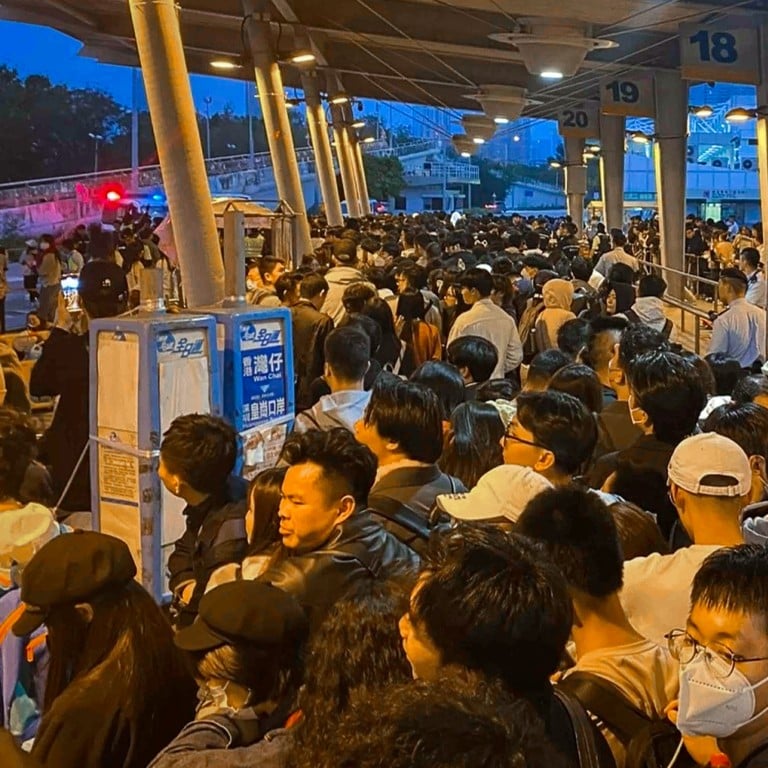
Explainer | How Hong Kong hopes to avoid repeat of New Year’s Eve’s border chaos and why easier crossings can be double-edged sword
- Hong Kong plans to discuss proposal to extend operating hours of cross-border checkpoints connected by railway services with mainland Chinese authorities
- The Post takes a look at what problems the city might face with night owl border crossings, and how they might affect the economy
The chaos that reigned as thousands of mainland Chinese tourists tried to head home after watching the New Year’s Eve fireworks in Hong Kong only to be delayed or stranded at the border has sparked calls for better connections.
The Hong Kong government a day after the transport trouble said it hoped to negotiate with its mainland counterpart over an extension to operating hours at checkpoints connected to rail services and adding more that offered round-the-clock services.
Authorities also promised to better coordinate transport arrangements in advance of any future large events so visitors could get home more easily.
The Post takes a look at what problems Hong Kong might face with night owl border crossings, and how they might affect the city’s economy.
1. Why are authorities seeking to extend the checkpoints’ operating times?
About 26,000 visitors descended on the Lok Ma Chau control point connecting Shenzhen’s Huanggang after watching the fireworks.
No 2 official Eric Chan Kwok-ki said the next day authorities would hold talks to their mainland counterparts to extend operating hours at some checkpoints served by trains and increase the number of round-the-clock border access points in the long run.
Hong Kong officials ‘learn lesson’ after new year transport chaos at border
Transport minister Lam Sai-hung said the government planned to extend operating hours at the Lo Wu and the Lok Ma Chau Spur Line-Shenzhen’s Futian checkpoints linked to the East Rail line during some festive periods to take advantage of the passenger capacity provided by mass transit.
Starry Lee Wai-king, Hong Kong’s sole delegate to the National People’s Congress Standing Committee, China’s top legislative body, said she had proposed to Beijing that it introduce 24-hour clearance services at the Shenzhen Bay and Heung Yuen Wai control points.
2. Which checkpoints are open round the clock?
There are 14 control points in the city and four of them are open 24 hours. They are the Hong Kong International Airport, Lok Ma Chau that connects Shenzhen’s Huanggang, Macau Ferry Terminal in Sheung Wan and the Hong Kong-Zhuhai-Macau Bridge.
Lok Ma Chau-Huanggang is the only control point that allows visitors to cross the border to and from Shenzhen at any time.
Alternatively, the mega bridge is another option for visitors to travel between Shenzhen and Hong Kong via Zhuhai, although it involves a long detour.

3. Which mainland authorities are involved in the operating hours?
Expanding cross-border services requires Beijing’s approval and collaboration with authorities in Guangdong and Shenzhen.
The National Development and Reform Commission, the state planning agency, earlier revealed a plan to add more 24-hour checkpoints to Hong Kong to boost the appeal of the Greater Bay Area to businesses.
Hong Kong minister vows to speed up talks on extending hours at border checkpoints
Immigration and customs arrangements at border checkpoints involve the Ministry of Public Security and the General Administration of Customs at the ministerial level, as well as the corresponding provincial departments.
Hong Kong policies are also overseen by the Hong Kong and Macau Affairs Office in Beijing.
The Post has contacted the Guangdong provincial government spokesman’s office for comment.
Hundreds of Hongkongers tour newly opened border town on New Year’s Day
Legislator Michael Tien Puk-sun, a former National People’s Congress deputy, said one barrier to the introduction of longer service hours at certain checkpoints was the transport arrangements on the Shenzhen side, which would involve the municipal authorities.
“Think about it – will we have enough connecting coaches serving 24 hours as well?” he asked.
“Will they keep running with only a couple of passengers on each coach?”
4. Is it time to extend service hours and add more 24-hour checkpoints?
Gary Ng Cheuk-yan, a senior economist at investment banker Natixis, said the introduction more 24-hour checkpoints would likely result in a “net loss” of consumption in Hong Kong in the short term.
The convenience would lead to even more Hongkongers crossing the border to spend, he warned.
But he added, if Hong Kong managed to deliver a comprehensive plan to lure tourists back, the same convenience might mean more mainland visitors would head south for leisure and shopping.
But some economists predicted southbound mainland travellers would take advantage of convenient border crossing times by staying in Shenzhen instead of Hong Kong, where hotel accommodation was more expensive.
They added that would frustrate the city’s goal of encouraging people from the mainland to stay longer in Hong Kong and spend.


